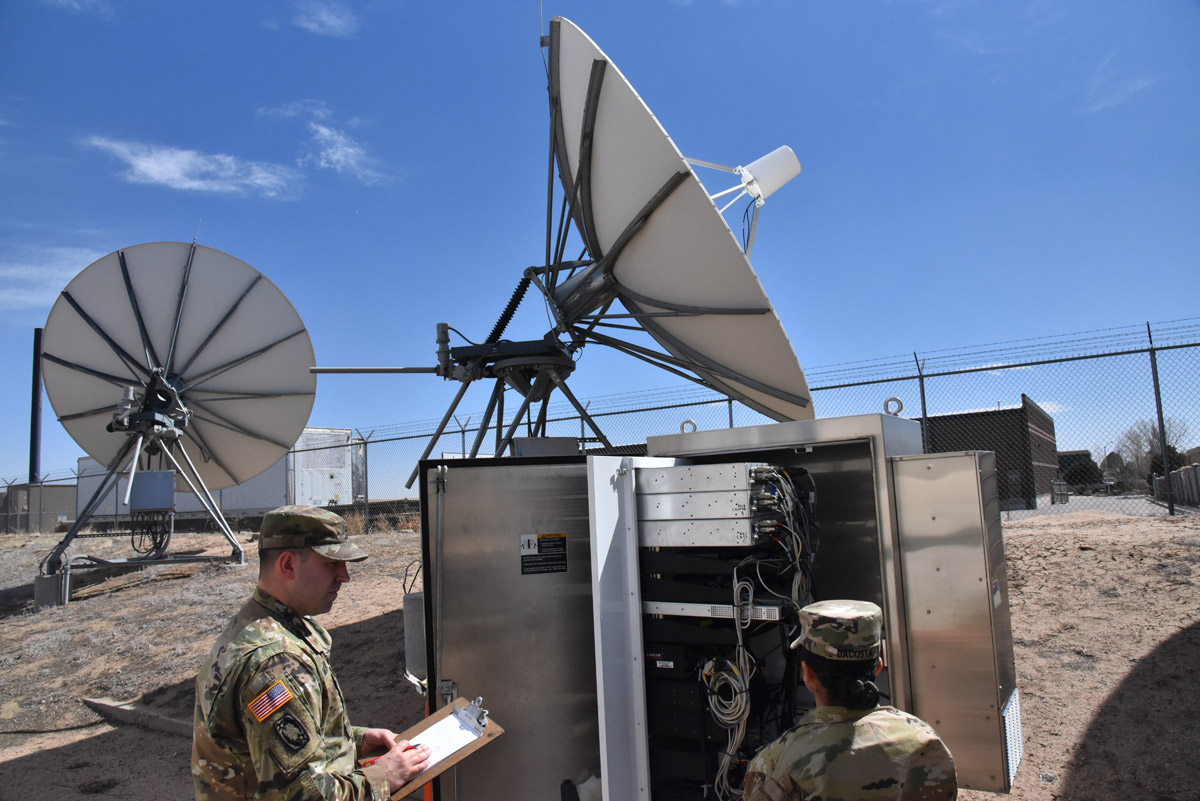 Staff Sgt. Travis Matzdorf, a Joint Tactical Ground Stations (JTAGS) initial qualification course instructor with U.S. Army Space and Missile Defense Command, evaluates Pvt. 2nd Class Amayah Dacosta, a JTAGS IQC student, on her data flow explanation of the JTAGS antenna enclosure at the Dr. Peter G. Pappas Training Facility in Colorado Springs, Colo., March 29, 2021. (Source: US Army/Sgt. 1st Class Aaron Rognstad)
Staff Sgt. Travis Matzdorf, a Joint Tactical Ground Stations (JTAGS) initial qualification course instructor with U.S. Army Space and Missile Defense Command, evaluates Pvt. 2nd Class Amayah Dacosta, a JTAGS IQC student, on her data flow explanation of the JTAGS antenna enclosure at the Dr. Peter G. Pappas Training Facility in Colorado Springs, Colo., March 29, 2021. (Source: US Army/Sgt. 1st Class Aaron Rognstad)
COLORADO SPRINGS, Col. — The U.S. Space Force (USSF) took another step to improve industry collaboration with the release of its Commercial Space Strategy this week. The strategy offers a general overview of Space Force priorities, definitions of concepts and specific mission areas where it will seek commercial help. It also highlighted four criteria that will be used in evaluating industry proposals for technology solutions going forward.
“We believe that understanding the guiding principles, our lines of effort and the criteria we will use to assess proposals will help our industry partners better understand our needs and how best to meet them,” said USSF Chief of Space Operations Gen. Chance Saltzman in a speech at the 39th Space Symposium in Colorado Springs, Col.
The criteria are largely focused on taking advantage of the commercial space sector’s technology innovation and relatively shorter development timelines. They cover:
- Operational utility
- Feasibility
- Resilience by design
- Speed to fielding
For operational utility, the service will focus on contracting for capabilities that directly satisfy an operational requirement. Saltzman noted, “We’re not just buying things because we can.”
This is closely related to feasibility, where the service will place a strong emphasis on the cost and value of commercial solutions compared to government-built systems.
Resilience is critical to reduce the risk and exposure inherent in using commercial solutions. Specifically, Saltzman cited proliferated architectures, disaggregated missions and cyber defense capabilities as features the service would look for when considering commercial solutions. “If commercial capabilities place a ‘protect and defend’ tax on the Space Force, they may not be as valuable as those that are able to protect themselves or operate effectively under contested circumstances,” he said.
Speed is also key. DoD has various innovation hubs to support R&D, but Saltzman made clear the service will prioritize solutions with a shorter time from concept to operational capability when considering proposals.
“Time matters because we’re running out of it,” Saltzman said. “We don’t have the luxury of waiting years for programs to deliver. The speed of need is right now and we will evaluate commercial capabilities not just on their level of innovation and capability, but also on the timeline to get it to the field and available for use by the Joint Force.”
‘Not a Panacea’
Saltzman acknowledged the strategy is “not a panacea” and did not cover issues as comprehensively as some industry collaborators hoped. While it offers a useful roadmap, it does not address critical industry questions about available funding or quantify USSF’s need for certain solutions.
 U.S. Space Force Chief of Space Operations Chance Saltzman addresses the 39th Space Symposium, April 10, 2024 in Colorado Springs, Col. (Source: Space Foundation)
U.S. Space Force Chief of Space Operations Chance Saltzman addresses the 39th Space Symposium, April 10, 2024 in Colorado Springs, Col. (Source: Space Foundation)
The strategy specified eight areas where Space Force will look—or continue—to integrate commercial space solutions. These areas are: Space domain awareness (SDA), satellite communications (SATCOM), space access, mobility and logistics (SAML), tactical surveillance, reconnaissance and tracking (TacSRT—formerly ISR), space-based environment monitoring (SBEM), cyberspace operations, command and control (C2) and positioning, navigation and timing (PNT).
The service specified that it would not seek commercial support for missile warning, combat power projection, electromagnetic warfare or nuclear detonation detection.
Indemnification? Maybe Not
The USSF strategy recognizes, ultimately, that risk is a two-way street. Just as USSF expects commercial vendors to mitigate exposure to risk through resilient architectures and cyber-secure solutions, industry also expects the government to protect against its level of exposure.
The USSF strategy places much of that responsibility on industry, stating, “Companies that choose to employ solutions in support of military operations must accept the inherent risk of doing so and take actions to protect their capabilities to ensure availability when needed, including in wartime.” In exchange, the service committed to aid industry by identifying threats and sharing timely information. The Space Force Chief Strategy and Resourcing Officer (CSRO) will develop the process for information sharing and address barriers, such as overclassification.
This line of effort is slightly different from the language in the U.S. Department of Defense’s Commercial Space Integration Strategy released in early April. The DoD strategy references insurance concepts, indemnification and cites “the use of military force to protect and defend commercial assets” as a potential backstop to the risks assumed by commercial space providers.
To financially protect commercial providers, the department says it will consider traditional commercial insurance, commercial war-risk insurance, U.S. government-provided insurance and indemnification to offset financial risk. However, it’s not clear whether these protections, which exist for commercial aviation and maritime providers, will be applied to commercial space.
“At the moment we don’t think we need that,” outgoing Assistant Secretary of Defense for Space Policy Dr. John Plumb told reporters at the Space Symposium. “At this moment in time, we think that by structuring our contracts correctly, both the commercial provider and the Department of Defense can get what they need and the commercial provider will be able to guarantee they’ll be here not just in peacetime but in crisis and conflict.”
Both the DoD and USSF strategies will take time to institute in culture and practice. Plumb indicated that the DoD has implementation guidance to facilitate its commercial space strategy and address barriers that may arise in the policy shift.
The Space Force is continuing to progress with commercial partnerships, including U.S. Space Command adding eight more companies to its Commercial Integration Cell at Vandenberg Space Force Base in California. The cell is one of several initiatives focused on achieving interoperability with commercial providers and creating peacetime opportunities for classified threat sharing, war-gaming and tabletop exercises.
Explore More:
Podcast with Col. Michael Christensen: Playing Poker, Changing Mindsets and Space Superiority
DoD’s Multilayers Space Network Focuses on Interoperability Challenges
Implications for Space Industry as Cyber Threat Actors Transition to Cloud Attacks
The Unconscionable ‘Day Without Space’
